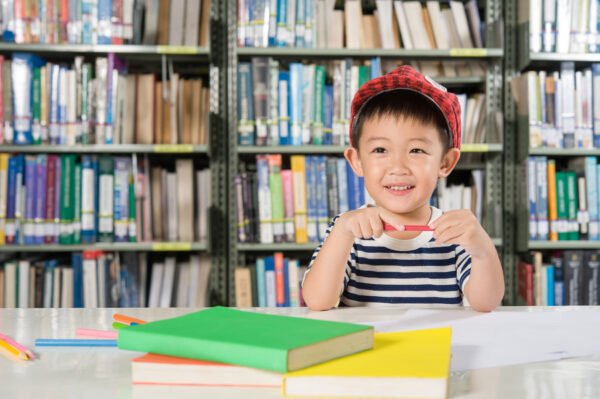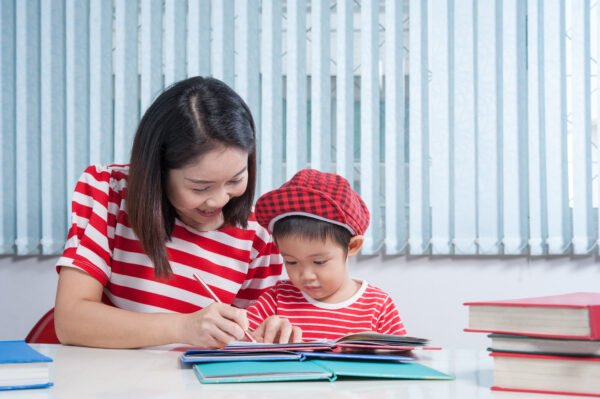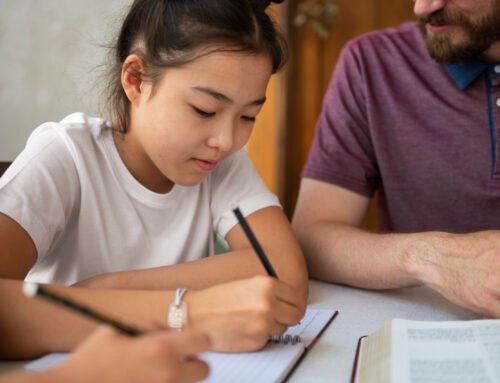MOE Chinese Curriculum: What Primary School Kids Are Expected to Know
MOE Chinese Curriculum: What Primary School Kids Are Expected to Know

Children in Singapore usually have MOE Chinese implemented as one of its curriculum. Aside from the main objective of helping children develop language skills, MOE Chinese curriculum is also aimed to assist in cultivating human qualities and fostering generic competencies. With its main objectives solidly set, MOE Chinese has different units meant to help children adjust with its curriculum, especially for those who are not familiar with Chinese language in general. As a Singaporean parent, knowing MOE Chinese course objectives per class level is important to track your children’s progress and assist them in maintaining their skills. In this article, we will discuss each primary class’ objectives and how to support their learning progress at home.
MOE Chinese Course Objective For Each Grade

Primary students from each class naturally have different capabilities in absorbing information and acquiring language skills. Although younger children are well-known for their natural ability in absorbing new information, lower primary students need to start with significantly easier material and focus more on the basis of tones, vocabulary drilling, and simple sentence structures. As its main objective is to encourage Chinese language fluency among children, MOE Chinese curriculum’s objectives can be divided based on the skills that children need to master. Here’s a comprehensive list of each level objective that your children need to achieve at school.
YOU MIGHT ALSO LIKE: The Primary School Parent’s Guide to Building Strong Chinese Foundations Early
Primary 1
As the first level of primary school, this first year will mainly focus on adjusting children to learning Mandarin as a second language. Primary 1 children are often expected to be able to recognize Chinese characters’ components and understand commonly used radicals.
In terms of listening comprehension, children around this level are expected to learn phonetic features such as syllables, initials, finals, rhymes, and tones. They are also expected to be able to understand basic visual and audio cues, such as hand gestures and intonation.
In terms of speaking, children in primary 1 will be taught on how to enunciate syllables and tones clearly. Although fluency is rather impossible to be achieved during their first year of learning MOE Chinese, children around this age will learn to relate their learning to real-life situations, where they are expected to be able to express simple feelings and opinions. Furthermore, they will also be able to answer simple questions asked by someone else.
In terms of reading comprehension, primary 1 children are often expected to be able to read shorter text format with the help of Pinyin and other complementary visuals to aid their experiences. This process aims to help children recognize Chinese characters. Given this help, they are expected to be able to understand simple text and find specific information based on their readings. This process should help them learn at least 700-750 new words in Chinese.
In terms of writing skills, children on the level of primary 1 are expected to be able to utilize Pinyin to help them with basic writing. During the end of primary 1, the aim is to have students mastering at least 300-350 Chinese characters.
YOU MIGHT ALSO LIKE: How to Find the Best Resources for Learning Chinese Pinyin Effectively for Kids
Primary 2
Similar to the previous level, primary 2 is often targeted to help children adjust themselves to the new learning environment. Therefore, its listening comprehension objective mainly still focuses on drilling the concept of syllables, tones, and consonants. By the end of the class, they are expected to be able to distinguish these differences perfectly as the next level will focus on more complex materials.
In terms of speaking skills, children around the age of primary 2 should be able to enunciate consonants and phrases more clearly than before. Furthermore, primary 2 students that are learning based on the MOE Chinese curriculum will be taught to adjust their volume levels and tones to match the speech intention. With constant practice, they are expected to be able to ask questions to others.
The main objective of reading comprehension for primary 2 students remains similar to its previous level with the focus on understanding how to read text with the help of Pinyin, with a target of understanding 750 words. Aside from reading, children in this level are also expected to be able to read texts aloud and match their tones with the corresponding expressions shown through the text.
As for writing skills, primary 2 students are expected to master 350 Chinese characters. They should also be able to use punctuation properly and identify radicals to help with forming sentences. With this ability, children around primary 2 level are also expected to be able to understand different mediums that can be used to write short messages, such as greeting cards.
Primary 3
Kids on primary 3 level are expected to master around 1300 words since they should have adapted with their learning environment. In terms of listening comprehension, primary 3 students should be able to differentiate intonations in Mandarin to distinguish between statement, exclamation, and questions. Based on what they’ve learned, children learning MOE Chinese in third grade should be able to arrange a sequence of events based on what they’ve listened to.
Assuming that children in the third grade have a solid foundation in tones and syllables, students on this level will be expected to have the capability to retell stories. Their speaking skills should also be able to quote others’ sentences and paraphrase it in different conversations.
Reading comprehension for children at this level is notably more advanced than the previous level. They should be able to understand the meaning of sentences upon quick inspection. They are also expected to be able to approximate text contents from its title and illustrations.
In terms of writing skills for primary 3, students will have to master at least 700 Chinese characters. As students in this level have a better grasp on observation, they should be able to recognize and complete sentences through written text.
Primary 4
Listening comprehension for primary 4 students often can be taken further than before to their ability to analyse situations. Instead of absorbing all information quickly, students on this level should be able to listen to Chinese conversations and understand the main points in no time. Furthermore, they can also understand the different points of view while extracting the Chinese sentences.
Primary 4 students’ speaking skills should be further developed so that they can have active communication with other people directly, each of them taking turns in giving out opinions. Kids around this level will also be able to actively participate in more complex discussions with peers.
Once they’ve reached primary 4, kids are expected to know 1350 words in Chinese which will help them with reading comprehension. Students on this level will also display the ability to recognise different types of longer reading materials, such as advertisements, stories, and news. With this ability, they are also expected to have a better grasp on how to deduce sentences’ meanings.
Students’ writing skills at the primary 4 level should cover at least 750 words. With how much vocabulary they’ve acquired through their learning, primary 4 students should be able to express their opinion in a written format. Furthermore, they should be able to write and arrange paragraphs.
Primary 5
Kids at this level are usually considered as upper primary students and are able to deepen their understanding in learning Chinese as a second language. Thus, their listening comprehension expands into the ability to distinguish different formats of verbal discussions. Children in primary 5 are also better at listening to Chinese conversations and can point out implicit messages through understanding their common phrases.
In terms of speaking skills, primary 5 students’ ability should be in alignment with their listening comprehension, where they will be able to choose the right phrases to express different viewpoints. With their naturally developing cognitive skills, children on this level are expected to be able to analyse and briefly explain about certain topics to others, similar to presentations.
Primary 5 students’ reading comprehension should cover at least 1600 Chinese words. MOE Chinese curriculum on this level will focus on longer texts, where students are expected to be able to understand the main points and give their opinions based on the text. Children around this age should also be able to distinguish between explicit and implicit texts.
When it comes to writing skills, children on primary 5 level should at least understand 1000 Chinese characters. Given how many Chinese characters they’ve mastered and how much sentence structure they’ve learned, students will be encouraged to revise texts and write certain topics to expand their creativity.
Primary 6
At the last level of primary school, students should have shown a lot of improvement in understanding Chinese as a second language. Primary 6 students’ listening skills should expand further by acquiring the ability to make predictions based on certain keywords they’ve heard.
Their speaking skills, on the other hand, should show much better fluency. This achievement is reflected with their ability to communicate effectively with people, choosing the right cues and phrases. Furthermore, they can also adjust their speech depending on the person they’re currently interacting with.
Primary 6 students’ reading comprehension are often reflected in their understanding of at least 1700 words. Advanced students can also achieve more, nearing 1900 words by the end of primary school. Their ability to read longer texts will be sufficient to help them implement knowledge to real-life situations. This curriculum will also focus on encouraging students to make comparisons and summaries based on the text they’ve read.
On the other hand, primary 6 students’ writing skills should cover 1100 words, with advanced learners being able to write approximately 1500 Chinese characters. Children on this level will not only understand different types of writing medium, but also acquire the ability to adjust their writing styles based on the formats needed.
How Parents Can Support MOE Chinese Curriculum at Home

MOE Chinese curriculum has been commonly found in many schools in Singapore, helping parents to ensure their children’s ability to use Chinese as they grow up. However, learning Chinese isn’t something that is exclusively taught in formal education centres. Despite its effective curriculum, children also need constant support from their family, especially parents. Here are a few practical tips that you can implement to help support your children learning MOE Chinese curriculum at home.
Gathering Learning Materials
Learning materials is one of the most important things that you can prepare to support your children learning the MOE Chinese curriculum. Usually, schools will provide the necessary textbooks needed to supplement students’ learning journey. Aside from purchasing these textbooks, you can also help support your children by browsing through additional learning tools to further help them in grasping concepts clearly.
Encouraging Children to Learn Beforehand
Before the school year starts, you can encourage your children to go through any available textbooks or other learning materials. To do this, children aren’t expected to master everything within a day, but rather knowing what they would be learning throughout the year. Taking this step ahead can help them adjust faster and ensure that their ability is on par with other peers.
Keeping Track on Assessment
Another important thing that you need to pay attention to is any assessment given by the school. This assessment can come directly during class period or taken home in a form of homework. Supporting your children to learn MOE Chinese at home can be achieved by accompanying their learning journey. For example, you can remind your children about their homework and encourage them to find help if they’re feeling stuck. Aside from helping children to hone their skills, the result of these assessments can be used to understand how well your children are taking their Chinese classes.
Incorporating Extra Lessons if Needed
Extra lessons are often necessary for several children, especially if your kid struggles with understanding materials solely through the Chinese curriculum at school. These extra lessons can be implemented by finding different courses depending on what your children struggle with. For example, if your children find difficulty in speaking, you can find conversational Chinese classes to let them grow better. Therefore, you need to observe and discuss with your children regarding their progress to help them find the best Chinese courses to help them thrive.
YOU MIGHT ALSO LIKE: What to Look for in a Good Chinese Enrichment Class for Kids
Learn MOE Chinese with EliteKid
MOE Chinese is a curriculum offered directly by the ministry of education in Singapore to help young children cultivate interest and skills in using Chinese as a second language. In school, children will be taught different skills ranging from listening comprehension, speaking skills, reading, and writing. Each level of primary school education in Singapore usually has the same main objective set by its government. However, there might be cases where children still struggle to keep up with their peers in learning MOE Chinese. If your children find difficulty in learning, enrolling in courses for MOE Chinese can be a great solution to help them get back on track. Learn more about our courses by visiting our site.





